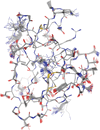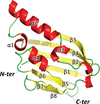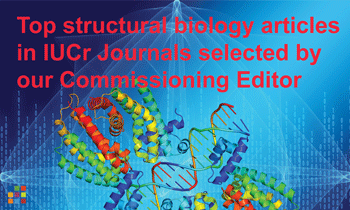issue contents
November 2021 issue

Cover illustration: Iodotyrosines in bovine thyroglobulin, the glycoprotein that is essential for the generation of thyroid hormones. [Kim et al. (2021), Acta Cryst. D77, 1451–1459]. The side chains and cryoEM map density fit for thyroxinated side chains at Tyr24 are shown.
scientific commentaries
Open  access
access
 access
access
A study of natively iodinated bovine thyroglobulin demonstrates that structural details of biologically important chemical reactions can now be visualized by electron cryo-microscopy.
CCP4
Download citation


Download citation


Open  access
access
 access
access
The predictive power of simulation has become embedded in the infrastructure of modern economies. The scientific and technical progress that needs to be made to improve the predictive power of biomolecular simulations and how this might be achieved are discussed.
Download citation


Download citation


Open  access
access
 access
access
Improvements to the ensemble refinement method are described and demonstrated. These improvements lead to more physically meaningful and interpretable macromolecular ensembles.
Open  access
access
 access
access
The study of cells replicating hepatitis C and treated with antiviral compounds by soft X-ray cryo tomography (cryo-SXT) and synchrotron-based infrared microscopy allows correlation of the viral structures resolved by the former with their chemical composition revealed by the latter. The results show the potential of cryo-SXT as a platform to determine the effectiveness of antiviral compounds in infected cells, guiding drug development at a preclinical level.
CCP-EM
Download citation


Download citation


Open  access
access
 access
access
The modification of a crystallographic molecular-replacement pipeline for use in fitting search models to cryo-EM maps is described.
research papers
Download citation


Download citation


Ambiguities in and the completeness of SAS data analysis of membrane proteins (MPs) are considered here in the case of the sensory rhodopsin II–transducer complex solubilized in a detergent. The contribution of the detergent belt surrounding MPs is one of the main problems in SAS data analysis of MPs; the second problem addressed here is the influence of oligomerization polydispersity (which is a sufficiently common phenomenon for MPs) on the quality of SAS structural analysis.
Download citation


Download citation


Open  access
access
 access
access
The structural and zinc-binding properties of PA4063, one of the periplasmic proteins expressed by Pseudomonas aeruginosa under zinc-deficient conditions, are presented. PA4063 has a noncanonical ferredoxin-like fold. Two zinc-binding sites with micromolar affinity are exposed and are located on the same face of the structure. Two histidine-rich loops, which are disordered in the apoprotein, contribute to zinc coordination in one of the sites. These findings strongly suggest a role for PA4063 in zinc trafficking, possibly acting as a metal chaperone or as a regulator of a transport system.
Download citation


Download citation


The first structural insight is provided into DNA recognition by the SorC/DeoR family of bacterial transcriptional regulators. Crystal structures of the DNA-binding domains of CggR and DeoR from Bacillus subtilis were determined in complexes with their DNA operators.
Download citation


Download citation


The crystal structure of the β-mannanase KMAN from Klebsiella oxytoca KUB-CW2-3 and its mechanism of hydrolysis are reported.
PDB reference: KMAN from K. oxytoca KUB-CW2-3, 7eet
Download citation


Download citation


The REMARK280 field from the PDB was used to create an updated screen based on the most successful commercially available crystallization conditions. The new screen considers both the diversity of the screen along with the success of each of the conditions.
Download citation


Download citation


Open  access
access
 access
access
Thyroglobulin is the precursor protein that serves as a substrate for thyroid hormone synthesis. Here, a three-dimensional cryoEM reconstruction of bovine thyroglobulin at an overall resolution of 2.6 Å is presented. The structure facilitates the definitive identification of thyroxine (acceptor) and dehydroalanine (donor) sites at two of the most evolutionarily conserved sites of hormone formation in vertebrates.
EMDB reference: bovine thyroglobulin, EMD-24181
PDB reference: bovine thyroglobulin, 7n4y
Download citation


Download citation


Open  access
access
 access
access
The crystal structures of SdgB and SdgA from Staphylococcus aureus provide functional and structural insights into the glycosylation mechanism in staphylococcal adhesion.
obituaries
Open  access
access
 access
access


 journal menu
journal menu


































